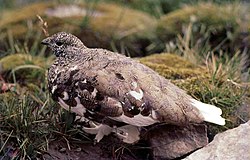White-tailed ptarmigan
| White-tailed ptarmigan | |
|---|---|
 |
|
| Scientific classification | |
| Kingdom: | Animalia |
| Phylum: | Chordata |
| Class: | Aves |
| Order: | Galliformes |
| Family: | Phasianidae |
| Subfamily: | Tetraoninae |
| Genus: | Lagopus |
| Species: | L. leucura |
| Binomial name | |
|
Lagopus leucura (Richardson, 1831) |
|
 |
|
| White-tailed ptarmigan range | |
| Synonyms | |
|
|
The white-tailed ptarmigan (Lagopus leucura), also known as the snow quail, is the smallest bird in the grouse family. It is a permanent resident of high altitudes on or above the tree line and is native to Alaska and the mountainous parts of Canada and the western United States. It has also been introduced into the Sierra Nevada in California, the Wallowa Mountains in Oregon and the Uinta Mountains in Utah. Its plumage is cryptic and varies at different times of the year. In the summer it is speckled in gray, brown and white whereas in winter it is wholly white. At all times of year the wings, belly and tail are white. The white-tailed ptarmigan has a diet of buds, leaves, flowers and seeds. The nest is a simple depression in the ground in which up to eight eggs are laid. After hatching, the chicks soon leave the nest. At first they eat insects but later move on to an adult diet, their mother using vocalisations to help them find suitable plant food. The population seems to be stable and the IUCN lists this species as being of "Least Concern".
The white-tailed ptarmigan is the smallest of the ptarmigans and the smallest bird in the grouse family. It is a stocky bird with rounded wings, square-ended tail, small black beak and short legs with feathering extending to the toes. Adults are 11.8 to 12.2 inches (30 to 31 cm) long, with the males being only slightly larger than the females. The average weight is 11.6 to 16.9 ounces (330 to 480 g). During the summer, the white-tailed ptarmigan is a speckled grayish brown with white underparts, tail and wings. In the fall, the plumage has turned a much more reddish-brown color and white feathers begin to grow through. By winter all the summer brown feathers are lost and the bird is completely white. A further molt in the spring precedes the breeding season and the bird returns to its summer plumage. The finely-barred greyish coloration on the back makes it easy to distinguish this species from the much browner willow ptarmigan and rock ptarmigan. Both sexes maintain white tail and wing feathers all the year and males can be identified by their reddish eyecombs (fleshy growths above the eye), also present year-long. In general this bird is silent but it sometimes makes quiet, low-pitched hoots and soft clucking noises.
...
Wikipedia

